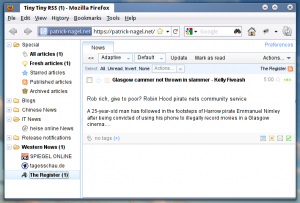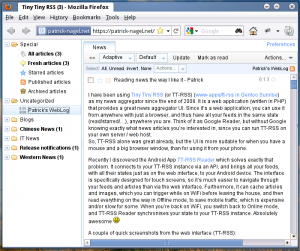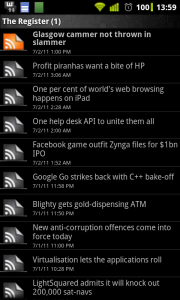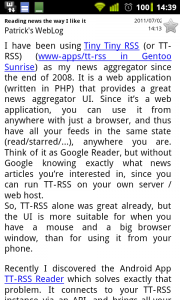It’s 2012, and there are still people who don’t put all their information onto Google/Facebook/… servers. Call them paranoid control freaks, if you want. 😉
Some of them even run their own e-mail server. Those people would probably prefer to have their address book(s) and calendar(s) stored on their own server as well, which Android cannot do out of the box.
This blog post aims to give a brief overview over my current solution to this problem. It’s not 100% perfect yet, but I am quite satisfied with it already. I have been using this setup for a couple of months now, and did not encounter any problems of relevance. (*)
Software components involved
On the server:
- DAViCal – a free (GPL licensed) CalDAV/CardDAV server written in PHP; needs PostgreSQL as database server
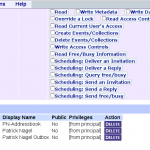
- Roundcube Webmail with the CardDAV plugin – to manage your contacts from within any web browser (Roundcube is of course also a decent mail client)
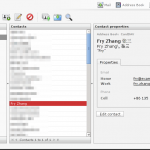
On the desktop / laptop computer:
- Mozilla Thunderbird with
- Lightning extension – to manage your calendar(s) from your Linux/Windows/Mac computer
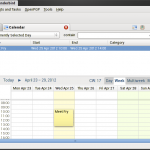
- SOGo connector extension (this link brings you to a file listing where you can download a nightly snapshot, there is no officially released version for current Thunderbird versions on the SOGo download page, yet) – to manage / lookup your contacts from your Linux/Windows/Mac computer
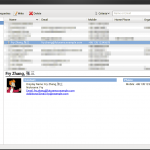
A few words on how to get the SOGo connector working (it’s not really straight-forward, in my opinion): After installing the extension by dragging the downloaded .xpi file onto Thunderbird, open the Address book and choose Menu File / New / Remote Address Book. Enter the URL of your DAViCal CardDAV collection, i.e. https://your.server/davical/caldav.php/YOUR_USER/YOUR_COLLECTION. Then right-click on the new address book and choose Synchronize.
- Lightning extension – to manage your calendar(s) from your Linux/Windows/Mac computer
On the Android device:
- CalDAV-Sync app from Market or AndroidPIT for a bit more than 2€
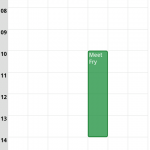
(Since CalDAV-Sync is just a backend app that facilitates syncing, this is a screenshot of the Android calendar, with the event that can be seen in the Thunderbird-Lightning screenshot above) - CardDAV-Sync app from Market or AndroidPIT for a bit less than 1.50€ or free
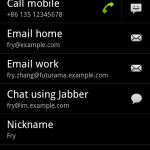
(Since CardDAV-Sync is just a backend app that facilitates syncing, this is a screenshot of the Android contact viewer, with the contact that can be seen in the Roundcube CardDAV screenshot above) - Contact Editor or Contact Editor Pro app from Market or AndroidPIT (Pro costs a bit more than 2€, the free version lacks a few features)
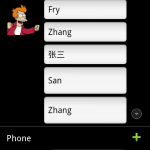
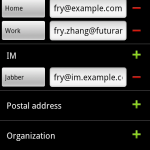
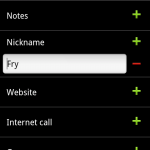
A few notes regarding the components:
- Contact Editor is necessary because the default Android contact editor somehow does not work with custom contact sources. It integrates seamlessly once you have set it as default action upon adding/editing a contact for the first time after installation.
- The SOGo connector extension for Thunderbird is a good start, but in the long run I really hope Thunderbird’s contact handling can be brought to a level that matches the rest of the application. There is hope.
- There seems to be a calendar plugin for Roundcube as well (as part of the MyRoundcube plugin collection), and it seems to support CalDAV, but I couldn’t get it to work so far (and did not try hard, since I always have a Thunderbird with Lightning around, which is great for calendaring).
I’m planning to write more on how to get everything set up, but I currently don’t have time for that. The hardest part is getting DAViCal and PostgreSQL to work, in my opinion, all the other components basically just need a URL (to the previously set up DAViCal collection – e.g. https://your.server/davical/caldav.php/YOUR_USER/YOUR_COLLECTION), username and password to work.
Update (2012-01-28): Added some screenshots.
By the way, what must be a very recent change in Gentoo’s packaging of PHP causes CalDAV-Sync to fail syncing, and the apache error log contains “[Sat Jan 28 08:30:48 2012] [error] [client x.x.x.x] PHP Fatal error: Call to undefined function cal_days_in_month() in /…/davical/inc/RRule-v2.php on line 906” if you do not enable the ‘calendar’ USE flag for dev-lang/php (which is disabled by default).
Update (2012-01-29): (*) Typical, I write about something, and then it breaks. It seems there is an incompatibility between the newly released DAViCal 1.0.2 and CalDAV-Sync. The CalDAV-Sync developer has confirmed the issue and is working on it.
Update (2012-01-30): The incompatibility – resulting in logged error messages – does not affect functionality (it was just me having set the account to “One-Way-Sync”)
Update (2012-02-09): Great news: There are nightly builds of the SOGo connector Thunderbird extension that provides CardDAV integration for Thunderbird 10 now – I knew that extension before, but development seemed to have stopped at Thunderbird 3.5 or so. I added links and a bit of info above.
Update (2012-02-09/2): I found the first bug with SOGo connector – when saving a contact that has an image, the image gets lost. This doesn’t really matter to me, because I don’t use images in contacts usually, but for people who use images, this could be annoying. Hope they fix it.
